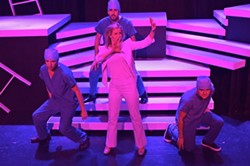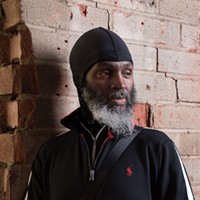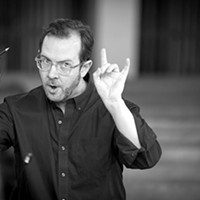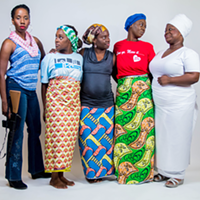Holding on for dead life in Next to Normal
Nothing ordinary about QCTC's sterling production
By Perry TannenbaumImmersing us immediately in the point-of-view the mom, Diana, Next to Normal presents the Goodman family through the lens of her mental illness. We don't see the difference between what she sees and the rest of the family sees right away, but it's radical enough when it smacks us in the face. One of Diana's children is only alive in her diseased mind — destroying her and the family in the process.
The Pulitzer Prize-winning book and lyrics by Brian Yorkey made quite a splash on Broadway in 2009, largely because of Yorkey's trenchant analysis of how Diana's vicissitudes eat away at the family fabric. Along with the salvos launched against modern psychotherapy and pharmacology, the show is spiced with a caustic score by Tom Kitt. As a result, a curious, curative alchemy prevails. Hard as it is sometimes to watch all this suffering, we can take solace in watching how much more difficult and draining it all is to perform.
While the original Broadway version starring Alice Ripley wasn't exactly enormous, director Glenn T. Griffin has taken a typical Queen City Theatre Company approach in downsizing the production for Duke Energy Theatre. The result is a more intimate family portrait, one less likely to be perceived as a musical tirade in boldface caps on what is happening in America today. It's more personal. When Diana communes with the sweater, the booties and the music box of her dead child, you can hear every deep breath and poignant sob, and the climactic "Maybe" reconciliation between mother and daughter is more moving up close.
This may be the most remarkable performance Alyson Lowe has given us yet — it is certainly the most musically and emotionally intense. Her Diane is more alluring, more wired and more melodramatic than Ripley's, and Griffin's costume designs add extra flair. Lowe has flexed these muscles and tics before, but in Evil Dead the Musical, she was doing it just for laughs. By dialing back that over-the-top zombie romp so that it is nearly as natural as Ripley is a chilling feat.
Billy Ensley, on the other hand, is more pallid and humdrum as Diana's husband than J. Robert Spencer was on Broadway, an approach to Dan that seems truer to the script. While empathizing deeply with Dan's suffering patience, Yorkey doesn't make him a romantic hero. One of the most telling songs of the evening, "How Could I Ever Forget?" has Dan and Diana remembering the same day — when their son died — and singing the same lament. But they're singing to different people: Diana is grieving over losing her son forever while Dan is grieving over losing her forever.
The irony is horrific. While Gabe remains alive for Diana, it's the real Diana who is truly dead and beyond reach.
Dan isn't the only neglected Goodman, and Griffin audaciously casts the remainder of the family. Considering that she'll be celebrating her 16th birthday before the next Loaf comes out, I'd say Abigale Corrigan is phenomenal as the tough, insulated and wrongly shunned Natalie. As much as we feel for her, Natalie is in some ways a carbon copy of her mom, barring the guy who loves her from her home — and escaping her troubles with Diana's stash of pills.
Griffin's confidence in Corrigan may have grown out of her appearance in Cybersoul last summer, a musical she co-wrote with another cast member, Matt Carlson. Ironically, the situation was flipped back then as Carlson played a budding rock star that Corrigan was pursuing. Here, Carlson is the outsider as Henry, Natalie's would-be beau. Parallels between the two couples remain clear but somewhat understated until a tumultuous "Why Stay?" quartet before the last of Yorkey's plot twists.
Opting for less comic relief, Griffin goes softer on the medical, pharmaceutical and psychotherapeutic establishments than the Broadway show. So Drs. Madden and Fine aren't quite as flamboyant as the roles Joe McCourt may have thought he was auditioning for. Not to worry; when Dr. Fine suddenly sparks with rock star charisma, McCourt has more than enough electricity in reserve. As the lost son Gabe, now grown up to the age of 18 in Diana's mind, it's left to Grant Zavitkovsky to summon up the highest voltage, his second rendition of "I'm Alive" even more shattering than the first.
Nearly a decade younger than either of the actors who were Gabe on Broadway, Zavitkovsky comes well within shouting distance of their firepower. All of the younger generation in the Queen City version are, in fact, more age-appropriate, a key reason why none of them pales in comparison.
Really, the demands are greater — and Griffin makes sure they're met. Tim Baxter-Ferguson's set concept is simpler and more dreamlike than the original two-story scaffolding, which was more like a generic rock concert or musical. We do get some strobe effects during Act 2 in John Hartness's lighting, but here again the design is more earthbound. On this smaller stage, we're close enough to see everyone's expression simultaneously in the various quartet and ensemble pieces. It takes exhaustive vigilance by the actors and director to ensure that it's all working so vividly, and the dedication is obviously there.
The payoff in intensity is huge. Except for the occasional squonk from the microphones, when tensions and decibels rise, everything at Duke Energy Theatre stands up to the closest scrutiny. Like the Children's Theatre's The Secret Garden down the block at ImaginOn, QC's Next to Normal makes a compelling smaller-is-better argument.
Speaking of...
Latest in Performing Arts
More by Perry Tannenbaum
Calendar
-

The Comic Strip (Comedy + Sip & Paint) @ Cloudcheck CLT
-

Seeing Auschwitz @ VAPA Center
-

NEW WINDOW GALLERY-Pat Rhea-ACRYLIC PAINTINGS-April 05-30 2024 VALDESE, NC 28690 @ New Window Gallery/Play It Again Records
- Through April 30, 12 p.m.
-

WHISKEY TASTING: VIRGINIA HIGHLANDS WHISKY @ Elizabeth Parlour Room
-
An Evening With Phil Rosenthal Of "Somebody Feed Phil" @ Knight Theater
-
The joy and pain of comedian Oletha Cuevas 2
-
The ugly truth in Sociales: Débora Arango Arrives Today
Living in a country and a time that required women to keep their heads down and their mouths shut, this artist did neither.
-
Charlotte Symphony Teams with Punk Violinist
Flaming redhead torches Red Priest

















